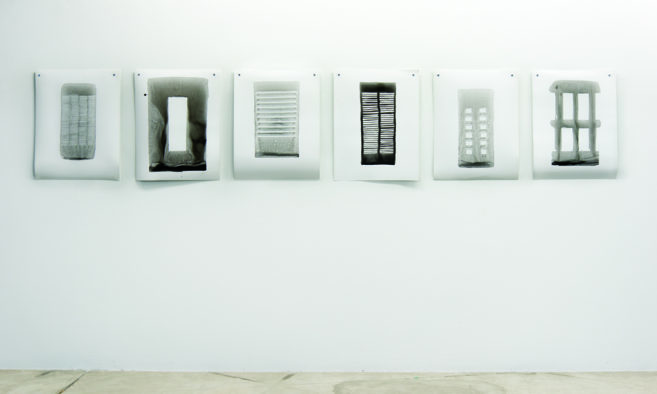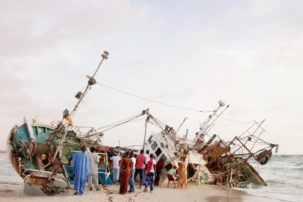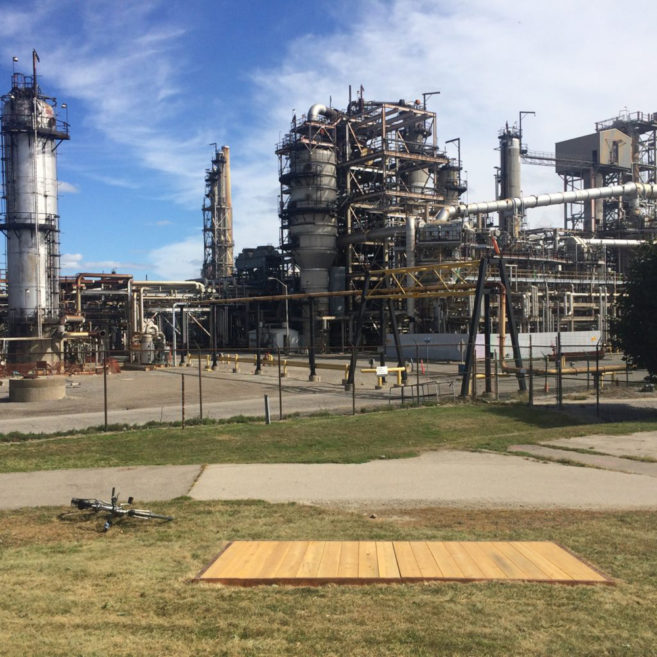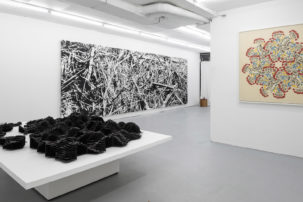On a warm May afternoon in San Francisco, Abbas Akhavan and I discussed his latest installation and first solo exhibition in the US “cast for a folly,” which astutely recalls a specific meeting point between culture and tyranny during the US-led invasion of Iraq. The slippages that take place in conversation between friends (what is left unsaid, misunderstood shorthand, decades-old anecdotes or theory remembered only to be misremembered) are a good place to start when considering what the artist has created during his residency through the Wattis Institute at California College of the Arts. In this exhibition, curated by Kim Nguyen (who wrote a poetic and illuminating text), Abbas takes the opportunity to transform one space into another, a mimicry of sorts (which is just another kind of slippage, from research to execution). “cast for a folly” adds up to an accumulation of stuffs that refers to the lobby of the National Museum of Iraq but does not, exactly, attempt to reproduce it. Having never been to Baghdad, Abbas bases his mimicry on a photograph taken by Corine Wegener, director of the Smithsonian Cultural Rescue Initiative, after the looting of the museum during the invasion of Iraq in 2003. The invasion led to the museum’s temporary occupation, which made way for the pilfering of thousands of cultural objects for either selfish resale or selfless safekeeping. (Museum curators noted that, upon reopening the devastated institution, thousands of objects were returned by citizens.)
Speaking with Abbas, I offer that what is reproducible is vastly different than what can exist as a referent—the important difference between pointing to and making a point. The strength in his installation is how he employs the referent without the pitfalls of the reproduction. This important difference is made clear in the sculptural elements that populate the installation: furniture based on those in the single photograph, estimated and (re)designed to seem accurate from a single vantage point—but whose falsehood is made obvious when the visitor walks through the gallery space. One notices that corners are clipped and entire panels are missing, a sculpture of a lion originally made of stone is recapitulated through dampened mud and straw and a slightly out-of-place green screen stands in for a set of grand doors. Dankness emanates from the sculpture and is echoed in the makeshift pond (a Rubbermaid bin filled halfway with water)—this haunted precarious feeling carries throughout the gallery.
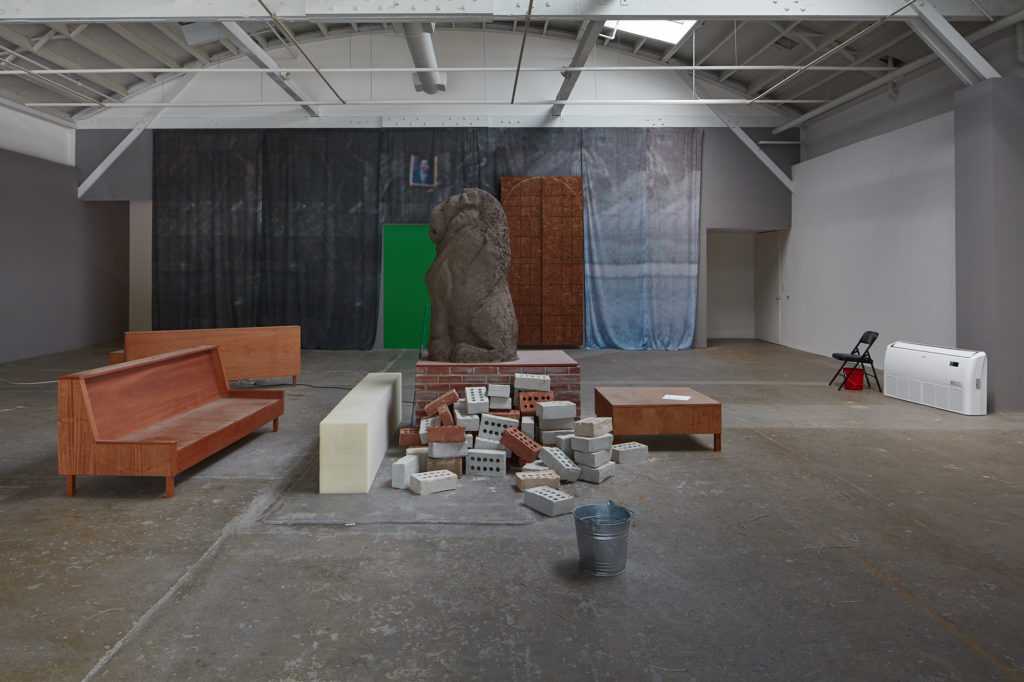
Abbas Akhavan, “cast for a folly,” 2019. Installation view at CCA Wattis Institute. Courtesy the artist/Catriona Jeffries/The Third Line. Photo: Johnna Arnold.

Abbas Akhavan, “cast for a folly,” 2019. Installation view at CCA Wattis Institute. Courtesy the artist/Catriona Jeffries/The Third Line. Photo: Johnna Arnold.
My conversation with Abbas turns toward dust. The threshold of the Wattis, an unlikely doppelgänger in proportion and scale for the National Museum of Iraq, is arranged into a mess of emptied display cabinets and benches standing akimbo. A lone picture of the deposed Saddam Hussein is barely legible but remains a focal point in the backdrop of both the source image and its re-creation in the gallery. Hussein’s image is made material here 15 years later as a small yet significant part of a mural-sized digital print on curtains that span the width of the room’s back wall. Indeed, everything in the gallery is covered in a particular layer of dust—the reproduced cabinetry, the seating that does everything but offer weary visitors a clean seat, and, of course, the lion sitting on its ramshackle, layered brick pedestal. In the way memory is filtered and becomes foggy, the layer of film that coats the windows of the cabinetry looks almost as if it has slipped from the soiled history of the invasion of Iraq. We rely on sources (living and dead) to recall just how it was, just how we felt, and maybe just what happened. What histories are carried by objects, and what does it mean for a museum to lose these important vessels? Better yet, what does it mean to re-present a museum void of its content? Can a cultural institution ever be divested of its purpose?
The most fertile slippages occur in language and, as a multilinguist, Abbas employs a poetic approach in teasing out double entendres while, thankfully, avoiding the easy puns rampant in English. He unpacks the exhibition’s multifarious title: “cast” as in a group of people (actors) or a method of reproduction (as in bronze), and “folly” as both an architectural term that refers to meaningless ornamentation (and through its ostentatiousness suggests an additional, improbable use) as well as the antecedent to foolishness (theatre). And so viewers are led to piece together, through the offerings of an artist and a curator working at the height of their mutual prowess, just how this assemblage of objects and stuffs calls into question the idea of replica, presentation and posterity.
Long admirers of Abbas’s work might ask what role plant life plays in this installation—we remember when he grew a garden throughout the Delfina Foundation in London, UK, or choreographed a subtle dance of planted and replanted cedar trees in a Quebec City pass-through, or the numerous fountains that spot his exhibition record. “cast for a folly” is auspiciously augmented by the makeshift Rubbermaid fountain, populated by lily pads and even a single lotus in bloom, as well as by the presence of grass clippings collected from a decommissioned US military fort in Presidio Park, California. The pile of grass clippings is added to over the months; a moneyed patron, I learn from Abbas, had to leave her visit to the Wattis earlier than anticipated following the onslaught of a nasty allergy attack, forcing the questions of why such museum spaces exist, how they continue to exist, and for whom. “cast for a folly” slips from hospitality to hostility in a few (not so) easy steps.
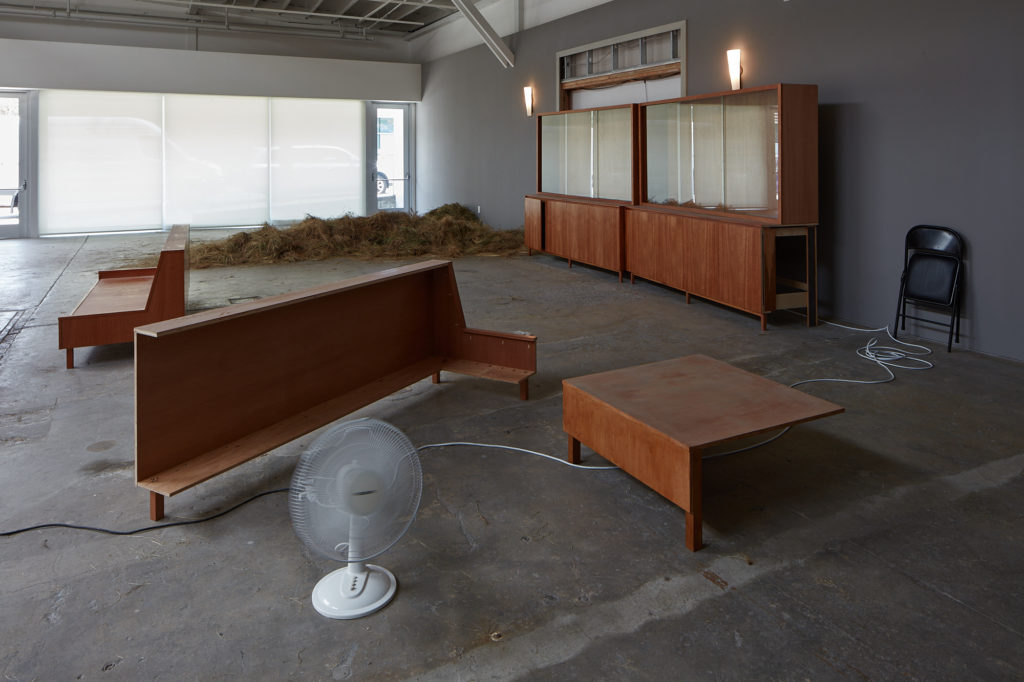
Abbas Akhavan, “cast for a folly,” 2019. Installation view at CCA Wattis Institute. Courtesy the artist/Catriona Jeffries/The Third Line. Photo: Johnna Arnold.

Abbas Akhavan, “cast for a folly,” 2019. Installation view at CCA Wattis Institute. Courtesy the artist/Catriona Jeffries/The Third Line. Photo: Johnna Arnold.

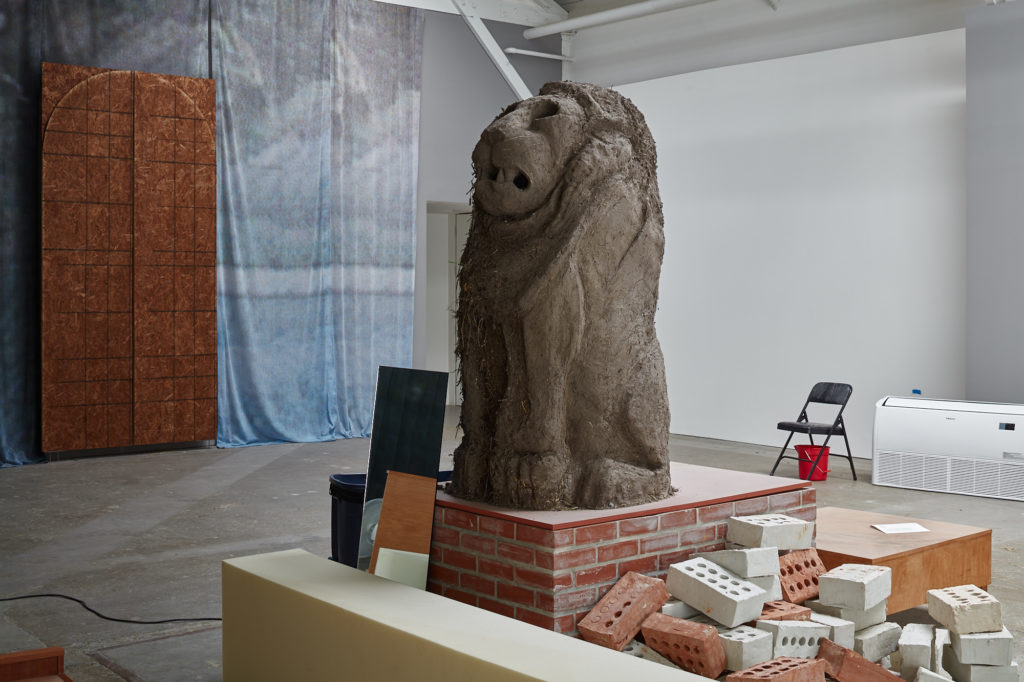 Abbas Akhavan, “cast for a folly,” 2019. Installation view at CCA Wattis Institute. Courtesy the artist/Catriona Jeffries/The Third Line. Photo: Johnna Arnold.
Abbas Akhavan, “cast for a folly,” 2019. Installation view at CCA Wattis Institute. Courtesy the artist/Catriona Jeffries/The Third Line. Photo: Johnna Arnold.
